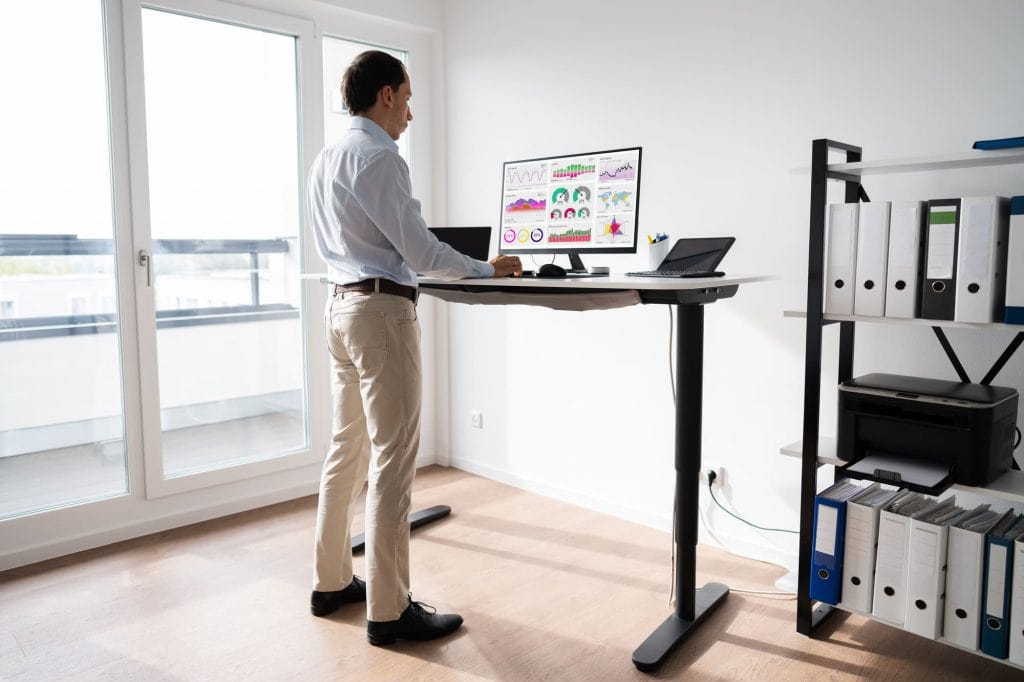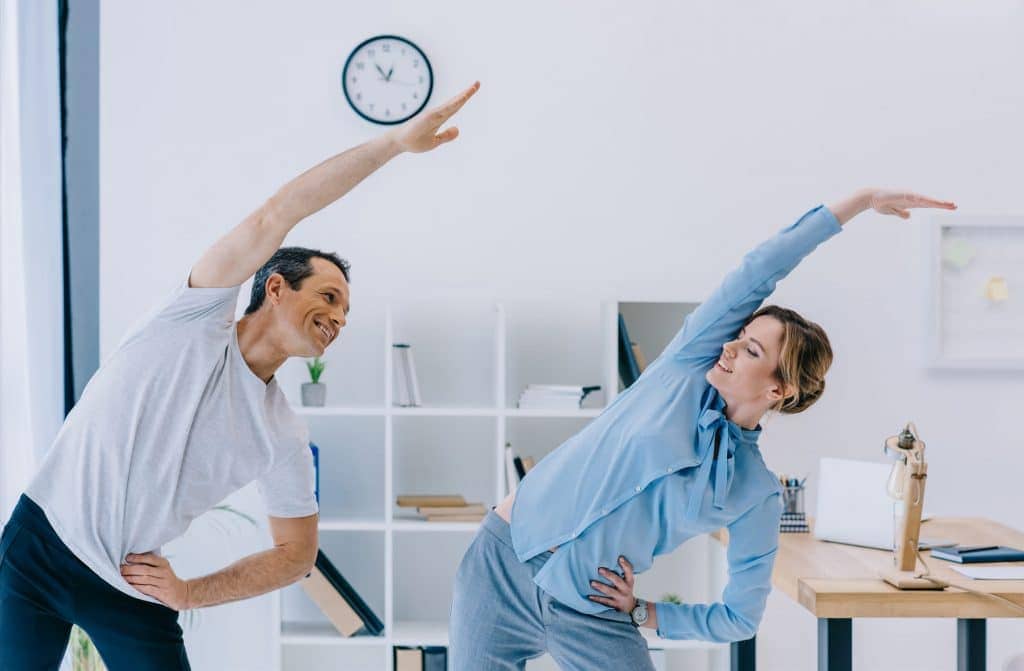*When you buy through links on our site, we may earn an affiliate commission at no additional cost to you.
If you spend long hours sitting in your office chair, you’re at high risk of the health problems tied to excessive sitting. These include obesity, type 2 diabetes, cardiovascular diseases, and even death!
However, the good news is that a standing desk allows you to stand while working and cuts down the sitting time.
But is the standing desk any better than a sitting desk? What benefits do you get from using standing desks?
In the following guide, we’ll dig deeper into the standing desks and help you decide if it’s really a good investment for your workspace.
Table of Contents
The risk of sitting for extended periods
We can’t talk about standing desks without mentioning what they’re intended to destroy—too much sitting or a sedentary lifestyle.
It has been scientifically proven that too much sitting can bring up a list of health concerns. These include obesity, increased blood sugar, increased blood pressure, excess body fat around your waist, and abnormal cholesterol levels.
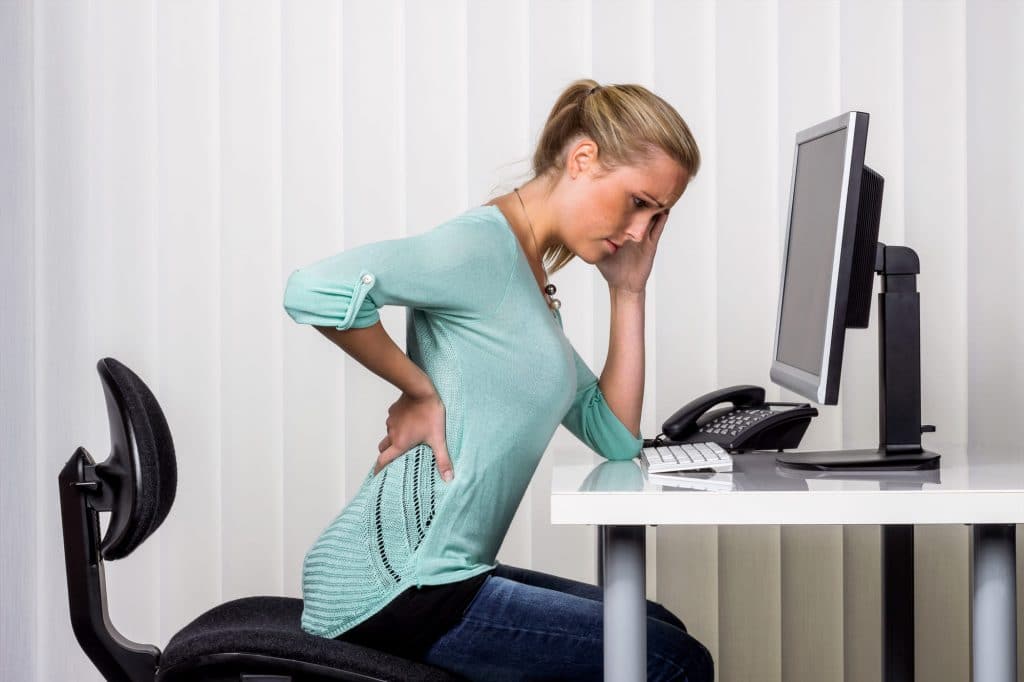
Spending too much time sitting in your office job will also increase the risk of premature death due to cardiovascular diseases or even cancer [1].
Preventing these health issues is much easier than treating them hence you need a standing desk for your desk job.
With prolonged sitting declared the new smoking, a standing desk is a medication you take to help you cut down on the packs you smoke throughout the day. And ultimately save you from the dangers that come with sedentary life.
In the next section, we’ll get a closer look at the top benefits that come with using a standing desk.
Benefits of a standing desk
Standing desks are all the rage among office workers who spend long days in the office but want to break from static sitting.
Most of these desks are height adjustable, allowing you to set them for sit-stand use. But some models come with a fixed height.
But generally, standing desks are height adjustable to enable you to bring them up or down to a level that you feel comfortable using them.

Some of these models are standalone, while others work as an extension of your existing office desk.
As we’ve just stated above, the primary reason behind the invention of a standing desk is to break free from static and the health risks it comes with.
This is how you benefit from using a standing chair:
Encourages a better posture
One of the greatest benefits of using a standing desk is that it promotes good posture. As you already know, maintaining the correct posture is key to preventing stress and chronic pain in your body.
This is especially true if you spend long periods of time at your desk or in front of the computer. Although ergonomic office chairs fight poor posture, you’ll find that it’s more natural to assume a good posture when standing smart, which is what a standing chair is made for.
According to this Harvard Medical School, your spine bones (vertebrae) get correctly aligned if your posture is good. And this saves you from back pains.
Minimizes back pain
A standing desk can also help reduce or prevent back pains. One of the greatest risks to sitting down for a long time is that it negatively affects your spine. You may feel your back stiff and sore after prolonged sitting. And this leads to back problems.
A standing desk helps prevent or minimize back pains by forcing you to work your core muscles. This muscle activity will strengthen the core stomach and back. And they’ll support your body instead of using the wrong muscles and overcompensating.
Minimizes the risk of weight gain
One of the biggest scares of sitting all day is that obesity will catch up with you sooner or later.
However, introducing a standing desk in your workstation helps ensure keep you from weight gain. This comes from the simple fact that standing promotes energy expenditure.
Thus, you burn more calories standing than when sitting. However, you should understand that standing burns not too many calories.

And you shouldn’t expect to see noticeable results immediately you switch to a standing desk.
Makes you more productive
Experienced office workers link standing desks to increased work output! This echoes the findings of research conducted on call center employees, which showed using standing desks to be 45% more productive than their counterparts who sat on a daily basis [2].
Switching to a standing desk can also help boost your productivity. After you’ve been sitting on your standard office seat and you feel like you can’t focus more, try transitioning to a standing desk, and it will do the trick.
Blood will get following, and you’ll find yourself working faster and doing your tasks more effectively and accurately than when sitting.
Drawbacks of sit-stand desks
Despite the many benefits, a standing desk isn’t 100% flawless office furniture. It may also prove to be a health hazard, especially if not properly used.
This section will look at the downsides of a standing desk.
Causes leg and feet pain
If you stand for too long on your standing desktop, you’ll put pressure on your feet, hips, and knees as they’re forced to bear the weight of the rest of your body for a long time.
This will most likely cause aches. You may try lifting one foot off the floor to ease the pressure, but it will throw you off balance and affect your posture.
Increases the risk of varicose veins
Yes, standing for a long time can invite varicose veins and other cardiovascular-related problems like deep vein thrombosis. This is because you’ll be forcing your heart to work against gravity to keep the blood flowing up from the toes.

Mind you, a study in the American Journal of Epidemiology in 2017 focused on the health of 7,000plus professionals in various professional fields and found out that those who stand more at the job have double the risk of getting heart disease than those who sit over a period of 12 months [3].
In concluding this study, the author noted that combining sitting and standing is key to enjoying beneficial cardiovascular health benefits.
Can cause back pains
We already mentioned that one of the top benefits of a standing desk is minimizing or preventing backaches.
However, standing too much can overturn this benefit and make you suffer from back problems. See, too much standing will compress your spine. And this results in undesired spinal pressure that leads to lower back problems over time.
How to use a standing desk properly?
By learning how to use a standing desk properly, you will gain all the benefits listed above while avoiding the above “side effects” that come with it.
Below are some top tips to help you use your standing desk properly:
Alternate between sit and standing
The main reason you’re using a standing desk is to avoid sitting for long hours. But standing for too long isn’t good either.
Workers whose occupations involve standing for long hours, e.g., the bank tellers and production line workers, tend to develop lower back pains.
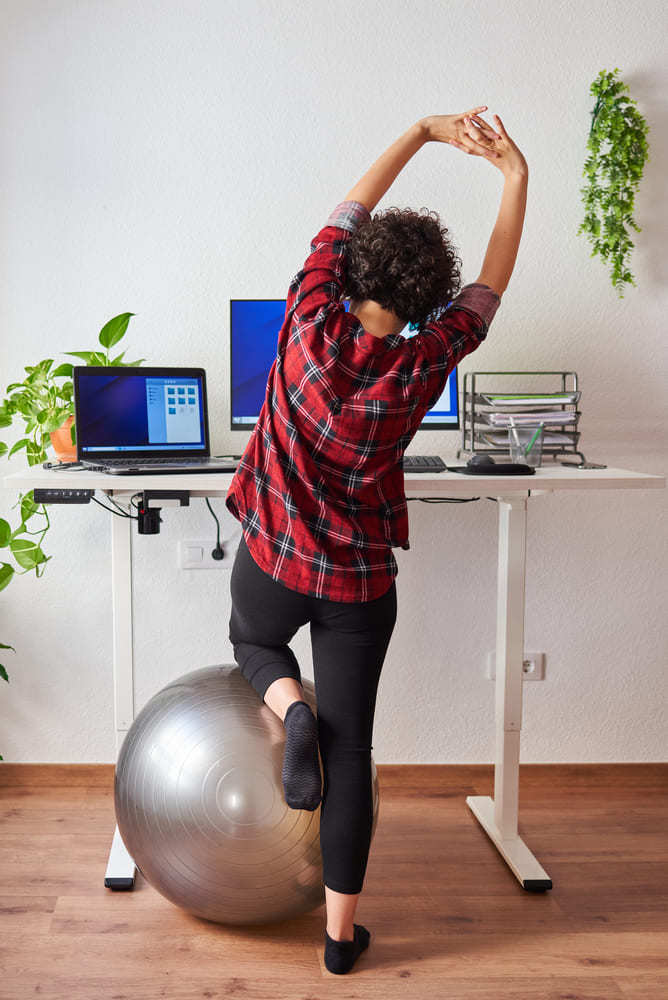
Even worse, sending long hours standing on your desk can hurt your leg muscles, connective tissue, and tendons.
You may even end up with varicose veins.
That said, you can avoid these risks of standing for long by alternating between the sitting and standing positions.
So, how long should you be standing?
Well, experts recommend that for every 1 hour of standing, you should spend 1-2 hours on a sitting desk.
Adjust the desk and screen to a comfortable position
Another tip to help you comfortably use your sit-stand desk and avoid straining and risk of injury is setting it and the computer screen in a comfortable position.
Most standing desks are height adjustable to enable you to easily raise or lower them to a comfortable height. We advise you to bring the desk at elbow height (that is, your elbow should sit 90 degrees from the floor) for a comfortable working experience.
A user of average height (around 5’11”) should have the standing desk set 44 inches high.
As for the computer monitor, make sure it stands at the perfect height and distance from your face. Ideally, you want it to stand at a height that doesn’t force you to strain your neck to get the perfect view. Consider setting it at a distance of around 20-28 inches from your face.
And make sure the top of the screen is at eye level. A small upward tilt between 10-20 degrees is allowable. This is the perfect screen position to prevent straining your head.
Take breaks
Alternating between a standing and sitting desk isn’t enough when using a standing desk. Taking breaks when using this desk is also helpful in improving your overall experience with it.
Breaks will help you clear your head and give you a chance to stretch your body and even rest your eyes.
Taking a break comes automatically for most people, but some will need a reminder.
If you belong to the latter category, we recommend using software that reminds you to take regular breaks throughout your workday.
Use the desk with an anti-fatigue mat
Using an anti-fatigue mat is a great way to fight the discomfort of using a standing desk.
A typical mat gives your legs the extra cushioning they need to feel comfortable and stay in a standing position for long hours without feeling fatigued and uncomfy.
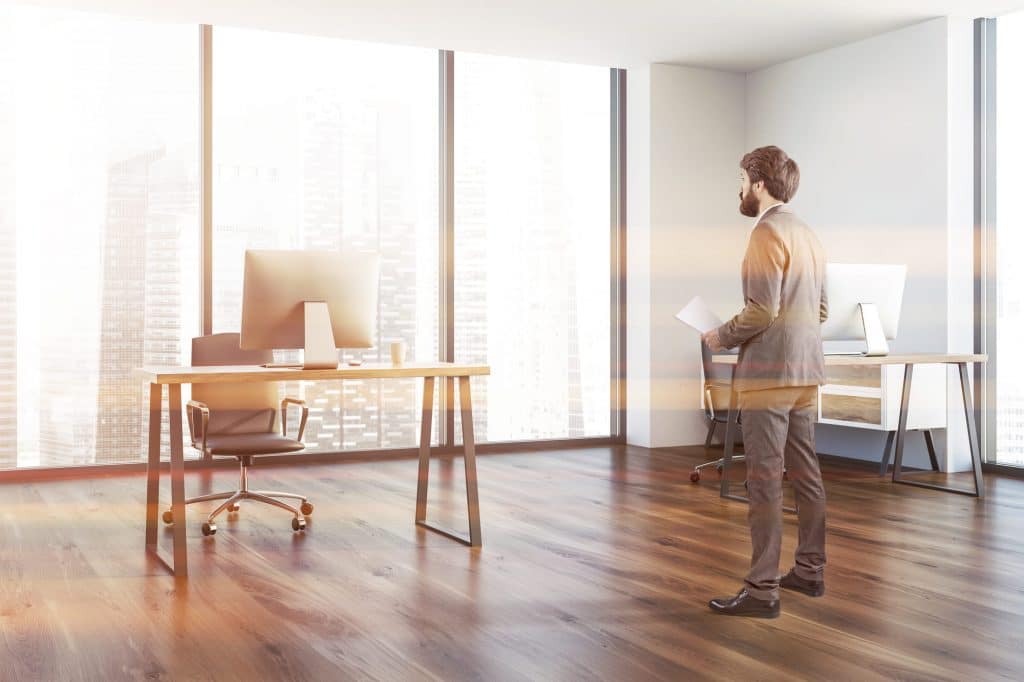
It also encourages subtle movements of the leg muscles. This helps improve blood circulation to your legs and feet while reducing the overall discomfort and tiredness of standing.
What’s more, this mat can help if you suffer from lower back or leg pain due to standing.
Put the keyboard and mouse in a strain-free position
Using your computer when standing for too long can put a strain on your wrists. That’s why you should optimize your wrist position when using the standing desk.
That said, you should make sure your keyboard and mouse stay at the same level when standing. And keep your wrists straight. Your wrist angle should be slightly different from the sitting desk—i.e., a bit more extended and tilting upwards.
If you usually experience wrist strains while standing, get an adjustable keyboard stand and a gel mouse pad to offer optimal support and minimize your discomfort.
Equip it with arm supports
Introducing arm supports on your standing desk will help reduce pressure on your wrists as it operates on the mouse. This further improves your wrist comfort and minimizes discomfort. Adding arm supports can also help fight neck and shoulder, especially on your dominant hand side.
BONUS TIP: Don’t replace exercise with a sit-stand desk
Some people may use a standing desk as an excuse to not exercise just because it helps burn calories. However, it’s good to keep in mind that you get more calories burned when walking, cycling, or running.
This is because these activities promote even higher rates of energy expenditure. No matter how frequently you use it, a standing desk will never count as exercise.
We advise you to incorporate a workout routine in addition to getting a standing desk to better your health and wellbeing.
Can you sit at a standing desk?
You can sit at a sit-stand desk. You will find various models of chairs and stools meant for use with sit-stand desks to enable you to use these desks while sitting.
However, sitting on a standing desk will defeat its primary purpose: to make you get out of the office chair and stand up while working.
Nether less, these chairs will come in handy since there are some tasks you can’t do while standing. For instance, drawing and writing are much more comfortable and easier to do on sitting desks.
Tasks involving fine motor skills are best done while on a sitting desk.

In this case, a drafting chair is a good option. This model offers the comfort of sitting desks while elevating you to a height where you can comfortably do your computer work on your standing desk.
It’s also worth that these sit-stand desk chairs aren’t designed to offer the same sitting experience as the conventional desks chairs.
Take, for instance, the perching stool that makes you lean instead of sitting as you normally do when using sitting desks. Generally, these chairs make sure you remain active while on the standing desk.
The chairs are a great way to help you avoid standing for long hours. They enable you to take breaks between sit and stand positions, which is ideal for using your standing desk.
Also, check out our article about how standing desks actually work.
Final Verdict – Are Standing Desks Better Than Sitting Desks?
Standing desks are a good way to encourage getting off your traditional office chair. They help you avoid health problems that arise with too much sitting, including obesity, diabetes, and heart problems.
However, this doesn’t mean you should fully transition to a standing desk and abandon your traditional office chair.
Standing for too long isn’t good for you. It can cause pain to your feet, legs, and hips. It interrupts your circulation. And it may also cause back pains.
Alternate between the sitting and standing desks if you want to enjoy all the benefits offered by standing versus sitting.
For every 1 hour of standing, sit for 1-2 hours, and you’ll be safe from the risks associated with too much sitting or standing.

